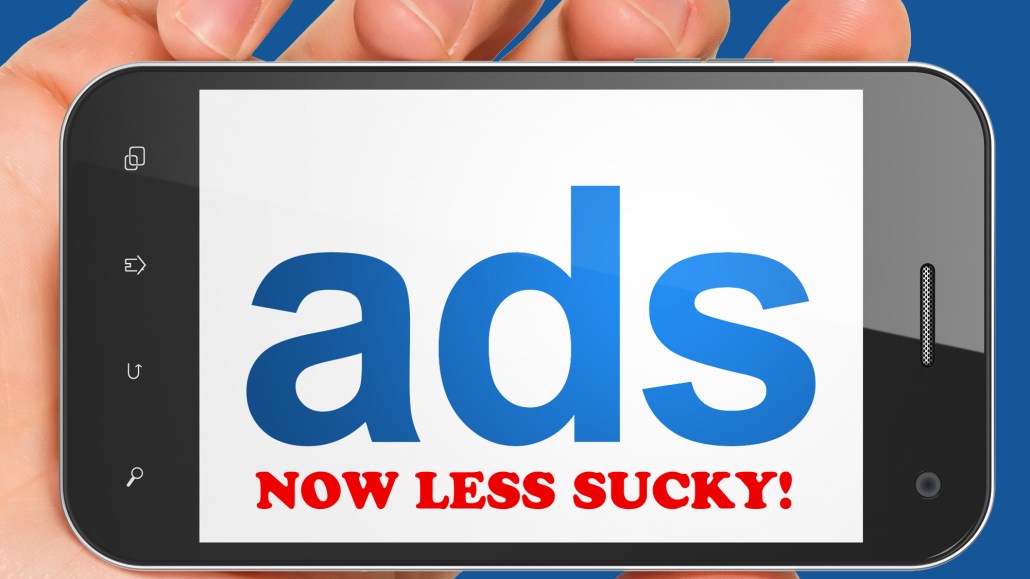
This is the third installment of a four-part series that explores how agencies are adapting to mobile. The series is sponsored by Celtra, the global leader for rich media mobile ad serving and analytics.
Mobile advertising is horrible. Sure, there are some great examples of rich, interactive mobile ad campaigns out there, but when was the last time you came across one in the wild? The fact is that for most consumers mobile ads register as little more than those grainy, illegible banners that they ignore as they move around the Web.
With that in mind, we asked a range of agency executives what they think marketers should do to make mobile ads suck a little less. Here’s what they said:
Make fewer of them
In the world of mobile advertising, inventory supply has far outstripped demand. The result has been millions of cheap ad impressions plastered all over apps and mobile sites from low-rent advertisers. To date, few brands have really spent big on mobile ads. Agency execs suggest both publishers and marketers would benefit from making fewer mobile ad opportunities available. “Publishers should optimize around exclusivity, share of screen, and impact rather than the number of impressions,” said David Berkowitz, MRY chief marketing officer. “Granted, that’s true for desktop, too. But on mobile, there’s less room for error.”
Don’t be lazy
Despite their promise, mobile ads are often just grainy static images that look like they’ve been ported over from the desktop. That’s often because they have. Agencies say that because mobile media can be bought so cheap, spending big on creative isn’t always a budget priority. But bad ads are hurting mobile campaigns nonetheless.”Stop with the resizing,” said Kayla Green, director of digital strategy at Saatchi & Saatchi LA. “We often see banners that were resized from desktop ads, and it’s hard to see the images, read the copy or even know what it’s about. Design for the small screen.”
Use the device to your advantage
Agency execs say the worst mobile ads are ones that make no attempt to make use of, or even acknowledge, the fact they’re being served to a mobile device. Mobile ads give marketers the opportunity to incorporate location-specific content, access features like accelerometers and calendars, or even just to do something fun with touchscreen functionality. “Hilton ran mobile-enabled ads that showed vacation-destination ads based on the current location and weather,” said Matt DeSimone, senior interactive producer at Click 3X. “That breaks the mold of generic content being displayed for every eyeball.”
Offer mobile content and experiences
It’s amazing how many mobile ads still drive users to landing pages that aren’t optimized for mobile use. Paying to drive users to a generic website and expecting them to pinch and zoom to navigate is poor form. But beyond that, the most effective mobile ads drive users to content and experiences that are not only functional, but relevant to the device they’re using, agencies say. “One reason Facebook has done so well with mobile advertising is that a high percentage of its mobile ads push mobile apps, and apps that are, of course, targeted to the user’s operating system,” said Berkowitz. “Advertisers don’t always need their own mobile apps, but if they have some kind of content that’s designed for mobile devices, that will be more elegant to mobile users.”
Help, don’t advertise
Marketers increasingly talk about offering “utility” to consumers, especially around mobile. But often they settle for just bombarding users with messaging instead. It’s about time marketers thought more carefully about the type of impression they leave on consumers by getting in their way, as opposed to helping them achieve something. “We can’t continue to treat mobile ads like a traditional print piece. Instead of filling people’s phones with promotions, we must first ask ourselves how we can uniquely add to their mobile experience,” said Terry Lewis, a strategist at creative shop Sid Lee. “I may not want to hear that another product is 20 percent off today, but I will remember the brand that recommends a taxi in a new town or delivers a piece of interesting content while I’m stuck in traffic.”
Image via Shutterstock
More in Marketing

The anatomy of an agency chief client officer
Several major agencies have moved to appoint chief client officers to their top cohorts lately.

How marketers rank this year’s generative AI image, video tools
Digiday’s 2025 agency generative AI report card explores the winners and losers of the generative AI landscape.

In memoriam: Brands we lost in 2025
Digiday Media staff rounded up some of the most notable brand names we lost in 2025, like Joann and Rite Aid.





